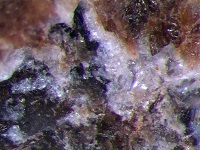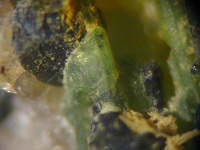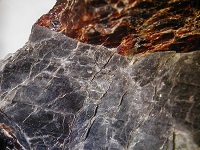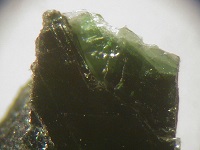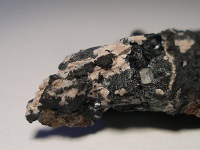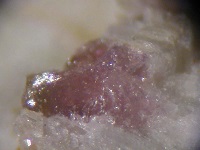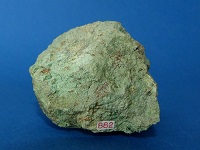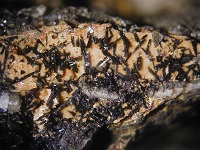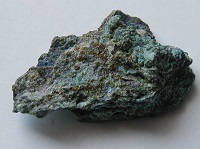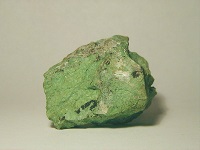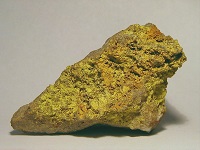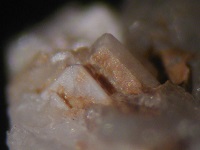|
|
|
|
|
|
|
|
|
|
|
|
MINERAL CLASSIFICATION / SYSTEMATIK der MINERALE
based on E.H. Nickel & M.C. Nichols (2009), H. Strunz & E.H. Nickel (2001)
9. SILICATES
(Silicates, Germanates)
9.E: Phyllosilicates
|
|
9.EA. Phyllosilicates with single nets of tetrahedra with 4-, 5-, 6-, 8-, and 14-membered rings |
| |
|
9.EA.05. Searlesite |
| |
| |
Searlesite | |
NaBSi2O5(OH)2 | |
| |
| |
G |
| |
Searlesite contains single layers of nets of borate and silicate tetrahedra with 4- and 5-membered rings.
|
|
|
9.EA.07. Bavenite group |
| |
| |
Bavenite | |
Ca4Be2+xAl2-xSi9O26-x(OH)2+x (x = 0 - 1) | |
orth., Cmcm | |
| |
Rd |
| |
Bohseite | |
Ca4Be4Si9O24(OH)4 | |
orth., Cmcm | |
| |
Rd |
| |
Bavenite and Bohseite structures: layers of 4- and 6-membered rings of SiO4, (Si,Al)O4 and
(Si,Be)O4 tetrahedra, linked by (Si,Al)O4 tetrahedra and Ca.
|
|
|
9.EA.10. Gillespite group |
| |
| |
Gillespite | |
BaFe2+Si4O10O | |
| |
| |
|
| |
Cuprorivaite | |
CaCuSi4O10O | |
| |
| |
|
| |
Wesselsite | |
SrCuSi4O10O | |
| |
| |
|
| |
Effenbergerite | |
BaCuSi4O10O | |
| |
| |
|
| |
The minerals of the gillespite group contain single layers of nets of tetrahedra with 4- and 8-membered rings.
|
|
|
9.EA.12. Ekanite |
| |
| |
Ekanite | |
Ca2ThSi8O20 | |
tetr., I422 | |
FOTO | |
A |
|
|
9.EA.15. Shlykovite group |
| |
| |
Shlykovite | |
KCaSi4O9(OH)·3H2O | |
mon., P21/c | |
FOTO | |
IMA 2008-062 |
| |
Cryptophyllite | |
K2CaSi4O10·5H2O | |
mon., P21/n | |
FOTO | |
IMA 2008-061 |
| |
The crystal structures of Shlykovite and Cryptophyllite contain layers with 4- and 8-membered rings. The layers are composed of 3-periodic loop-branched
chains with a 4-membered ring of tetrahedra, connected in a way that additionally 8-membered rings are formed. Two tetrahedral layers are connected via
an octahedral component of edge-sharing chains of CaO5(H2O) octahedra, forming TOT blocks. K is
situated in voids of the octahedral layer. The interlayer between the TOT blocks contains in Shlykovite only H2O, and
in Cryptophyllite K and H2O (Zubkova et al., 2010).
|
|
|
9.EA.17. Apophyllite group |
| |
| |
Fluorapophyllite-(Na) | |
NaCa4Si8O20F·8H2O | |
tetr., P4/mnc | |
| |
IMA 1976-032, Rn |
| |
Hydroxyapophyllite-(K) | |
KCa4Si8O20(OH,F)·8H2O | |
tetr., P4/mnc | |
| |
Rn |
| |
Fluorapophyllite-(K) | |
KCa4Si8O20F·8H2O | |
tetr., P4/mnc | |
| |
Rn |
| |
Fluorapophyllite-(Cs) | |
CsCa4Si8O20F·8H2O | |
tetr., P4/mnc | |
| |
IMA 2018-108a |
| |
Fluorapophyllite-(NH4) | |
(NH4)Ca4Si8O20F·8H2O | |
tetr., P4/mnc | |
| |
IMA 2019-083 |
| |
Hydroxymcglassonite-(K) | |
KSr4Si8O20(OH,F)·8H2O | |
tetr., P4/mnc | |
| |
IMA 2020-066 |
| |
The minerals of the apophyllite group contain single layers of nets of tetrahedra with 4- and ellipsoid 8-membered rings.
|
|
|
9.EA.20. Cavansite |
| |
| |
Cavansite | |
Ca(V4+O)(Si4O10)·4H2O | |
orth., Pcmn | |
| |
IMA 1967-019 |
| |
Cavansite structure: layers of 4- and ellipsoid 8-membered rings of silicate tetrahedra. The layers are connected by
irregular CaO4(OH2)4 polyhedra and VO5
square based pyramids (Hughes et al., 2011).
|
|
|
9.EA.22. Bussyite group |
| |
| |
Bussyite-(Y) | |
(Y,REE,Ca)3(Na,Ca)6MnSi9Be5(O,F,OH)34 | |
mon., C2/c | |
| |
IMA 2014-060 |
| |
Bussyite-(Ce) | |
(Ce,REE)3(Na,H2O)6MnSi9Be5(O,OH)30F4 | |
mon., C2/c | |
| |
IMA 2007-039 |
| |
Bussyite structure: layers of 4-, 5- and 8-membered rings of SiO4, (Si,Be)O4
and BeO3F tetrahedra.
|
|
|
9.EA.25. Semenovite-(Ce) |
| |
| |
Semenovite-(Ce) | |
(Na,K)9Fe2+Ce2(Si,Be)20(O,OH,F)48 | |
| |
| |
IMA 1971-036 |
| |
Semenovite-(Ce): layers of 4-, 5- and 8-membered rings of SiO4 and BeO4 tetrahedra.
Alternatively, the structure motif can be described as branched 6-periodic single silicate chains, connected by BeO4 tetrahedra.
|
|
|
9.EA.27. Vladykinite |
| |
| |
Vladykinite | |
Na3Sr4(Fe2+Fe3+)Si8O24 | |
mon., P21/c | |
| |
IMA 2011-052 |
| |
Vladykinite: layers of 4-, 5- and 8-membered rings of SiO4 and FeO4 tetrahedra.
|
|
|
9.EA.30. Perettiite-(Y) group |
| |
| |
Perettiite-(Y) | |
Y2Mn2+4Fe2+[Si2B8O24] | |
orth., Pnma | |
| |
IMA 2014-109 |
| |
Badakhshanite-(Y) | |
Y2Mn2+4Al[Si2B7BeO24] | |
orth., Pnma | |
| |
IMA 2018-085 |
| |
Perettiite-(Y) structure: borosilicate layers of 4-, 5- and 8-membered rings.
|
|
|
9.EA.32. Dalyite group |
| |
| |
Davanite | |
K2TiSi6O18 | |
tric., P1 | |
| |
IMA 1982-100 |
| |
Dalyite | |
K2ZrSi6O18 | |
tric., P1 | |
| |
G |
| |
Dalyite and Davanite are phyllosilicates containing corrugated layers of 4-, 6- and 8-membered rings.
|
|
|
9.EA.35. Sazhinite group |
| |
| |
Sazhinite-(La) | |
Na3LaSi6O15·2H2O | |
orth., Pmm2 | |
| |
IMA 2002-042a |
| |
Sazhinite-(Ce) | |
Na3CeSi6O15·2H2O | |
orth., Pmm2 | |
| |
IMA 1973-060 |
| |
Sazhinite-(Ce) and -(La) structures: corrugated layers of 4-, 6- and 8-membered rings, similar to the minerals from the Dalyite group.
|
|
|
9.EA.37. Armstrongite |
| |
| |
Armstrongite | |
CaZr(Si6O15)·2H2O | |
mon., C2/m | |
| |
IMA 1972-018 |
| |
Armstrongite is a phyllosilicate containing corrugated layers of 4-, 6- and 8-membered rings.
|
|
|
9.EA.40. Yakovenchukite-(Y) |
| |
| |
Yakovenchukite-(Y) | |
K3NaCaY2Si12O30·4H2O | |
orth., Pcca | |
| |
IMA 2006-002 |
| |
Yakovenchukite-(Y) structure: single corrugated tetrahedral layers with 4-, 6- and 14-membered rings, connected by YO6
tetrahedra. Ca2+, K+, and Na+ cations are located within
the framework cavities (Krivovichev et al., 2007).
|
|
|
9.EA.42. Nekoite |
| |
| |
Nekoite | |
Ca3Si6O15·7H2O | |
tric., P1 | |
| |
G |
| |
Nekoite is a phyllosilicate containing layers of composition
(Si6O15)6-, with 5- and ellipsoid 8-membered rings. The structure
can be described as two 3-periodic chains are connected to a double chain with 5-membered rings. In one chain, all three silicate
tetrahedra pointing up, in the other chain one is pointing up, the other two down. These double chains are connected to a layer,
forming additional 8-membered rings (Alberti & Gallo, 1980).
|
|
|
9.EA.45. Okenite |
| |
| |
Okenite | |
Ca10Si18O46·18H2O | |
tric., P1 | |
| |
G |
| |
Okenite is an Ino-Phyllosilicate. The structure contains layers of 5- and 8-membered rings of silicate tetrahedra, with composition
(Si6O15)6-, and 3-periodic double chains with composition
(Si6O16)8-. Layers and chains are connected by octahedral
coordinated Ca to give complex layers. These complex layers alternate with Ca-water sheets. The structural formula is
[Ca8(Si6O16)(Si6O15)2(H2O)6][Ca2(H2O)9·3H2O].
|
|
|
9.EA.47. Zeravshanite |
| |
| |
Zeravshanite | |
Cs4Na2Zr3(Si18O45)·2H2O | |
mon., C2/c | |
| |
IMA 2003-034 |
| |
The crystal structure of zeravshanite contains layers of 5- and 8-membered rings of silicate tetrahedra.
|
|
|
9.EA.50. Pentagonite |
| |
| |
Pentagonite | |
Ca(V4+O)(Si4O10)·4H2O | |
orth., Ccm21 | |
| |
IMA 1971-039 |
| |
The crystal structure of pentagonite contains layers of hexagonal 6-membered rings of silicate tetrahedra. The layer can be described as 4-periodic chains
connected to a network, with all silicate tetrahedra pointing up in one chain, alternating with a chain with all silicate tetrahedra pointing down
(Evans, 1973).
|
|
|
9.EA.52. Plumbophyllite |
| |
| |
Plumbophyllite | |
Pb2(Si4O10)·H2O | |
orth., Pbcn | |
| |
IMA 2008-025 |
| |
The crystal structure of plumbophyllite contains layers of ellipsoid 6-membered rings of silicate tetrahedra.
|
|
|
9.EA.55. Sanbornite |
| |
| |
Sanbornite | |
Ba2Si4O10 | |
orth., Pmcn | |
| |
G |
| |
Sanbornite structure: single corrugated tetrahedral layers with ellipsoidal 6-membered rings, alternating with layers of Ba in coordination
number 9 (Hesse & Liebau, 1980).
|
|
|
9.EA.57. Silinaite |
| |
| |
Silinaite | |
NaLiSi2O5·2H2O | |
mon., A2/n | |
| |
IMA 1990-028 |
| |
Silinaite structure: single corrugated tetrahedral layers with ellipsoidal 6-membered rings, alternating with layers of
LiO4 tetrahedra and Na(H2O)4O2
octahedra (Grice, 1991).
|
|
|
9.EA.60. Lipuite |
| |
| |
Lipuite | |
KNa8Mn5Mg0.5[Si12O30(OH)4](PO4)O2(OH)2(H2O)4 | |
orth., Pnm | |
| |
IMA 2014-085 |
| |
Lipuite structure: single corrugated tetrahedral layers with 14-membered rings, linked by cations.
|
|
|
| |
| |
|
9.EB. Phyllosilicates with double and triple layers of tetrahedra with 4-, 5-, 6-, 7- and 8-membered rings |
| |
|
9.EB.05. Rhodesite |
| |
| |
Rhodesite | |
K2Ca4[Si16O36(OH)2]·10H2O | |
orth., Pmam | |
| |
G |
| |
Macdonaldite | |
BaCa4[Si16O36(OH)2]·10H2O | |
orth., Pmam | |
| |
IMA 1964-010 |
| |
Melansonite | |
Na□KZr[Si8O19]·5H2O | |
orth., Pmam | |
| |
IMA 2018-168 |
| |
The crystal structures of Rhodesite and Macdonaldite contain layers with 4- and 8-membered rings. The layers are composed of
3-periodic loop-branched chains with a 4-membered ring of tetrahedra, connected in a way that additionally 8-membered rings
are formed. These layers are forming double-layers with a channel system, defined by 8-membered rings along b and
8-membered rings along c. The channels are occupied by K and H2O in rhodesite and by K and
H2O in Macdonaldite. The double-layers are connected via octahedrally coordinated Ca (Hesse et al.,
1992; Cannillo et al., 1968).
|
|
|
9.EB.10. Delhayelite group |
| |
| |
Delhayelite | |
K4Na2Ca2[AlSi7O19]F2Cl | |
orth., Pmmn | |
FOTO | |
A |
| |
Fivegite | |
K4Ca2[AlSi7O17(O2-x(OH)x)](H2O)2-x(OH)xCl (x = 0 - 2) | |
| | | | | |
orth., Pm21n | |
| |
IMA 2009-067 |
| |
Hydrodelhayelite | |
KCa2[AlSi7O17(OH)2](H2O)6 | |
orth., Pn21m | |
| |
IMA 1979-023 |
| |
The crystal structure of Delhayelite contains double-layers with 4- and 8-membered rings, similar to the double layers in
Rhodesite. The channels are occupied by K and Cl. The double-layers are connected via octahedrally coordinated Ca (Cannillo
et al., 1970); Pekov et al., 2009). The crystal structure of Fivegite and Hydrodelhayeleite are very similar. Hydrodelhayelite
is also closely related to rhodesite.
|
|
|
9.EB.15. Monteregianite-(Y) |
| |
| |
Monteregianite-(Y) | |
Na4K2Y2[Si16O38]·10H2O | |
mon., P21/n | |
| |
IMA 1972-026 |
| |
The crystal structure of Monteregianite-(Y) contains double-layers with 4- and 8-membered rings, similar to the double layers in Rhodesite. The channels in
the double layer are occupied by K and H2O. The double-layers parallel (010) are connected via an open octahedral sheet composed of
[YO6] and three distinct [NaO4(H2O)2]
octahedra (Ghose et al., 1987).
|
|
|
9.EB.20. Carletonite |
| |
| |
Carletonite | |
KNa4Ca4Si8O18(CO3)4(OH)·H2O | |
tetr., P4/mbm | |
| |
IMA 1969-016 |
| |
Fluorcarletonite | |
KNa4Ca4Si8O18(CO3)4F·H2O | |
tetr., P4/mbm | |
| |
IMA 2019-038 |
| |
The crystal structure of Carletonite contains double-layers with 4- and 8-membered rings, similar to the double layers in
Rhodesite and related minerals. Additionally, carbonate layers are present (Chao, 1972).
|
|
|
9.EB.25. Ajoite |
| |
| |
Ajoite | |
K3Cu20Al3Si29O76(OH)16·8H2O | |
tric. | |
| |
A |
| |
The crystal structure of Ajoite contains non-planar layers with 5-, 6- and 7-membered rings. These layers are forming double-layers with
a large channel-system, defined by elliptical 12-membered rings along a and circular 8-membered rings along b. The double-layers are connected via
octahedrally coordinated Cu (Pluth & Smith, 2002).
|
|
|
9.EB.30. Diegogattaite |
| |
| |
Diegogattaite | |
Na2CaCu2Si8O20·H2O | |
mon., C2/m | |
| |
IMA 2012-096 |
| |
The crystal structure of Diegogattaite contains double layers of SiO4-tetrahedra.
|
|
|
9.EB.35. Odigitriaite |
| |
| |
Odigitriaite | |
CsNa5Ca5[Si14B2O38]F2 | |
mon., C2/c | |
| |
IMA 2015-028 |
| |
The crystal structure of Odigitriaite contains double borosilicate layers, of 6-membered hexagonal rings of SiO4-tetrahedra
and 6-membered ellipsoid rings of SiO4 and BO4-tetrahedra.
|
|
|
9.EB.40. Esquireite |
| |
| |
Esquireite | |
BaSi6O13·7H2O | |
mon., C2 | |
| |
IMA 2014-066 |
|
|
9.EB.45. Chiappinoite-(Y) |
| |
| |
Chiappinoite-(Y) | |
Y2Mn(Si3O7)4 | |
orth., Ibam | |
| |
IMA 2014-040 |
| |
The crystal structure of Chiappinoite-(Y) contains triple-layer blocks, consisting of sinuous batisite-like chains and four-membered silicate
rings. Y and Mn are situated between the silicate layer blocks (Kampf & Housley, 2015).
|
|
|
9.EB.50. Günterblassite group |
| |
| |
Günterblassite | |
(K,Ca,Ba,Na,□)3Fe[(Si,Al)13O25(O,OH)4]·7H2O | |
orth., Pnm21 | |
| |
IMA 2011-032 |
| |
Hillesheimite | |
(K,Ca,Ba,□)2(Mg,Fe,Ca,□)2[(Si,Al)13O23(O,OH)6]·8H2O | |
orth., Pmmn | |
| |
IMA 2011-080 |
| |
The crystal structure of Günterblassite contains Rhodesite-type layers with 4- and 8-membered rings. These layers are
connected to a triple-layer block. In the middle layer additional tetrahedra are present.
|
|
|
9.EB.55. Umbrianite |
| |
| |
Umbrianite | |
K7Na2Ca2[Al3Si10O29]F2Cl2 | |
| |
| |
IMA 2011-074 |
|
|
| |
| |
|
9.EC. Phyllosilicates with mica sheets, composed of tetrahedral and octahedral nets |
| |
|
9.EC.05. Pyrophyllite group (di-octahedral TOT layer structures) |
| |
| |
Pyrophyllite | |
Al2Si4O10(OH)2 | |
| |
| |
|
| |
Ferripyrophyllite | |
Fe3+2Si4O10(OH)2 | |
| |
| |
|
|
|
9.EC.10. Talc group (tri-octahedral TOT layer structures) |
| |
| |
Talc | |
Mg3Si4O10(OH)2 | |
| |
| |
|
| |
Minnesotaite | |
Fe2+3Si4O10(OH)2 | |
| |
| |
|
| |
Willemseite | |
Ni3Si4O10(OH)2 | |
| |
| |
|
|
|
9.EC.15. Muscovite group (di-octahedral TOT layer structures + cations) |
| |
| |
Aluminoceladonite | |
KMgAl(Si4O10)(OH)2 | |
| |
| |
A |
| |
Ferroaluminoceladonite | |
KFe2+Al(Si4O10)(OH)2 | |
| |
| |
IMA 1995-019 |
| |
Manganiceladonite | |
KMgMn3+(Si4O10)(OH)2 | |
| |
| |
IMA 2015-052 |
| |
Celadonite | |
KMgFe3+(Si4O10)(OH)2 | |
| |
| |
A |
| |
Ferroceladonite | |
KFe2+Fe3+(Si4O10)(OH)2 | |
| |
FOTO | |
IMA 1995-018 |
| |
Chromceladonite | |
KMgCr3+(Si4O10)(OH)2 | |
| |
| |
IMA 1999-024 |
| |
Boromuscovite | |
KAl2(Si3BO10)(OH)2 | |
| |
| |
IMA 1989-027 |
| |
Paragonite | |
NaAl2(Si3AlO10)(OH)2 | |
| |
| |
A |
| |
Muscovite | |
KAl2(Si3AlO10)(OH)2 | |
| |
| |
A |
| |
Nanpingite | |
CsAl2(Si3AlO10)(OH)2 | |
| |
| |
IMA 1987-006 |
| |
Tobelite | |
(NH4)Al2(Si3AlO10)(OH)2 | |
| |
| |
IMA 1981-021 |
| |
Roescoelite | |
KV3+2(Si3AlO10)(OH)2 | |
| |
| |
A |
| |
Chromphyllite | |
KCr3+2(Si3AlO10)(OH)2 | |
| |
| |
IMA 1995-052 |
| |
Montdorite | |
KFe2+1.5Mn2+0.5Mg0.5(Si2Al2O10)(OH)2 | |
| |
| |
Rd |
| |
Ganterite | |
Ba0.5(Na,K)0.5Al2(Si2.5Al1.5O10)(OH)2 | |
| |
| |
IMA 2000-033 |
|
|
9.EC.20. Biotite group (tri-octahedral TOT layer structures + cations) |
| |
| |
Polylithionite | |
KLi2Al(Si4O10)F2 | |
| |
| |
IMA 1989-019 |
| |
Sokolovaite | |
CsLi2Al(Si4O10)F2 | |
mon., C2/m, C2, Cm | |
| |
IMA 2004-012 |
| |
Kreiterit | |
CsLi2Fe(Si4O10)F2 | |
mon., C2/m, C2, Cm | |
| |
IMA 2019-041 |
| |
Orlovite | |
KLi2Ti(Si4O10)(OF) | |
| |
| |
IMA 2009-006 |
| |
Gorbunvite | |
CsLi2(Ti,Fe)(Si4O10)(F,OH,O)2 | |
| |
| |
IMA 2017-040 |
| |
Norrishite | |
KLiAlMn3+(Si4O10)(OH)2 | |
| |
| |
IMA 1989-019 |
| |
Tainiolite | |
KLiMg2(Si4O10)F2 | |
| |
| |
G |
| |
Garmite | |
CsLiMg2(Si4O10)F2 | |
mon. | |
| |
IMA 2017-008 |
| |
Shirokshinite | |
KNaMg2(Si4O10)F2 | |
| |
| |
IMA 2001-063 |
| |
Yangzhumingite | |
KMg2.5(Si4O10)F2 | |
| |
| |
IMA 2009-017 |
| |
Balestraite | |
KLi2V5+(Si4O10)O2 | |
| |
| |
IMA 2013-080 |
| |
Voloshinite | |
Rb(LiAl1.5□0.5)(Si3.5Al0.5O10)F2 | |
| |
| |
IMA 2007-052 |
| |
Aspidolite | |
NaMg3(Si3AlO10)(OH)2 | |
| |
| |
IMA 2004-049 |
| |
Wonesite | |
(Na,K,□)0.5(Mg,Fe,Al)3((Si,Al)4O10)(OH,F)2 | |
| |
| |
IMA 1979-007a |
| |
Phlogopite | |
KMg3(Si3AlO10)(OH)2 | |
| |
| |
G |
| |
Fluorophlogopite | |
KMg3(Si3AlO10)F2 | |
| |
| |
IMA 2006-011 |
| |
Tetraferriphlogopite | |
KMg3(Si3Fe3+O10)(OH)2 | |
| |
| |
Rn |
| |
Fluorotetraferriphlogopite | |
KMg3(Si3Fe3+O10)F2 | |
| |
| |
IMA 2010-018 |
| |
Oxyphlogopite | |
K(Mg,Ti,Fe)3((Si,Al)4O10)(O,F)2 | |
| |
| |
IMA 2009-069 |
| |
Shirozulite | |
KMn2+3(Si3AlO10)(OH)2 | |
| |
| |
IMA 2001-045 |
| |
Annite | |
KFe2+3(Si3AlO10)(OH)2 | |
| |
FOTO | |
A |
| |
Fluorannite | |
KFe2+3(Si3AlO10)F2 | |
| |
| |
IMA 1999-048 |
| |
Tetraferriannite | |
KFe2+3(Si3Fe3+O10)(OH)2 | |
| |
| |
Rn |
| |
Suhailite | |
(NH4)Fe2+3(Si3AlO10)(OH)2 | |
| |
| |
IMA 2007-040 |
| |
Hendricksite | |
KZn3(Si3AlO10)(OH)2 | |
| |
| |
IMA 1965-027 |
| |
Trilithionite | |
KLi1.5Al1.5(Si3AlO10)F2 | |
| |
FOTO | |
Rd |
| |
Luanshiweiite | |
KLiAl1.5(Si3.5Al0.5O10)(OH)2 | |
mon. | |
| |
IMA 2011-102 |
| |
Fluorluanshiweiite | |
KLiAl1.5(Si3.5Al0.5O10)F2 | |
mon. | |
| |
IMA 2019-053 |
| |
Masutomilite | |
KLiAlMn2+(Si3AlO10)(OH)2 | |
| |
| |
IMA 1974-046 |
| |
Ephesite | |
NaLiAl2(Si2Al2O10)(OH)2 | |
| |
| |
A |
| |
Preiswerkite | |
NaMg2Al(Si2Al2O10)(OH)2 | |
| |
| |
IMA 1979-008 |
| |
Siderophyllite | |
NaFe2+2Al(Si2Al2O10)(OH)2 | |
| |
| |
A |
| |
Eastonite | |
KMg2Al(Si2Al2O10)(OH)2 | |
| |
| |
Rd |
|
|
9.EC.25. Margarite group, brittle mica (di-octahedral TOT layer structures + cations) |
| |
| |
Margarite | |
CaAl2(Si2Al2O10)(OH)2 | |
| |
| |
A |
| |
Chernykhite | |
BaV2(Si2Al2O10)(OH)2 | |
| |
| |
IMA 1972-006 |
|
|
9.EC.30. Clintonite group, brittle mica (tri-octahedral TOT layer structures + cations) |
| |
| |
Clintonite | |
CaAlMg2(SiAl3O10)(OH)2 | |
| |
| |
A |
| |
Ferrokinoshitalite | |
BaFe2+3(Si3AlO10)(OH)2 | |
| |
| |
IMA 1999-026 |
| |
Fluorokinoshitalite | |
BaMg3(Si3AlO10)F2 | |
| |
| |
IMA 2010-001 |
| |
Kinoshitalite | |
BaMg3(Si3AlO10)(OH)2 | |
| |
| |
IMA 1973-011 |
| |
Oxykinoshitalite | |
BaMg2Ti4+(Si2Al2O10)O2 | |
| |
| |
IMA 2004-013 |
| |
Anandite | |
BaFe2+3(Si3Fe3+O10)S(OH) | |
| |
| |
IMA 1966-005 |
| |
Bityite | |
CaLiAl2(Si2BeAlO10)(OH)2 | |
| |
| |
A |
|
|
9.EC.35. Montmorillonite group, Smectite (di-octahedral TOT layer structures + interlayer cations and water) |
| |
| |
Montmorillonite | |
(Na,Ca)0.3(Al,Mg)2Si4O10(OH)2·nH2O | |
| |
| |
G |
| |
Beidellite | |
(Na,Ca)0.3Al2(Si,Al)4O10(OH)2·nH2O | |
| |
| |
G |
| |
Nontronite | |
(Na,Ca)0.3Fe3+2(Si,Al)4O10(OH)2·nH2O | |
| |
| |
A |
| |
Volkonskoite | |
Ca0.3(Cr,Mg)2(Si,Al)4O10(OH)2·4H2O | |
| |
FOTO | |
Rd |
| |
Yakhontovite | |
(Ca,Na,K)0.2(Cu,Fe,Mg)2Si4O10(OH)2·3H2O | |
| |
| |
IMA 1984-032a |
| |
Kurumsakite | |
Zn8Al8V5+2Si5O35·27H2O (?) | |
| |
| |
Q |
|
|
9.EC.40. Saponite group, Smectite (tri-octahedral TOT layer structures + interlayer cations and water) |
| |
| |
Saponite | |
(Ca,Na)0.3(Mg,Fe)3(Si,Al)4O10(OH)2·4H2O | |
| |
| |
G |
| |
Ferrosaponite | |
(Ca,Na)0.3(Fe2+,Mg,Fe3+)3(Si,Al)4O10(OH)2·4H2O | |
| |
| |
IMA 2002-028 |
| |
Sauconite | |
Na0.3Zn3(Si,Al)4O10(OH)2·4H2O | |
| |
| |
G |
| |
Swinefordite | |
Ca0.2(Li,Al,Mg,Fe)3(Si,Al)4O10(OH,F)2·4H2O | |
| |
| |
IMA 1973-054 |
| |
Hectorite | |
Na0.3(Mg,Li)3Si4O10(F,OH)2·nH2O | |
| |
| |
Q |
| |
Stevensite | |
(Ca,Na)xMg3-ySi4O10(OH)2 (?) | |
| |
| |
Q |
| |
Spadaite | |
MgSiO2(OH)2·H2O (?) | |
| |
| |
Q |
| |
Zincsilite | |
Zn3Si4O10(OH)2·3.5H2O | |
| |
| |
Q |
|
|
9.EC.45. Vermiculite (tri-octahedral TOT layer structures + interlayer cations and water) |
| |
| |
Vermiculite | |
Mg0.7(Mg,Fe,Al)6(Si,Al)8O20(OH)4·8H2O | |
| |
| |
G |
|
|
9.EC.50. Chlorite group (TOT+O layer structures) |
| |
| |
Clinochlore | |
Mg5Al(Si3Al)O10(OH)8 | |
| |
| |
G |
| |
Chamosite | |
(Fe2+,Mg,Al,Fe3+)6(Si,Al)4O10(OH,O)8 | |
| |
| |
G |
| |
Pennantite | |
Mn2+5Al(Si3Al)O10(OH)8 | |
| |
| |
G |
| |
Gonyerite | |
Mn2+5Fe3+(Si3Fe3+)O10(OH)8 | |
| |
| |
G |
| |
Nimite | |
(Ni,Mg,Al)6(Si,Al)4O10(OH)8 | |
| |
| |
A |
| |
Baileychlore | |
(Zn,Fe2+,Al,Mg)6(Si,Al)4O10(OH)8 | |
| |
| |
IMA 1986-056 |
| |
Cookeite | |
(Al,Li)3Al2(Si,Al)4O10(OH)8 | |
| |
| |
G |
| |
Borocookeite | |
LiAl4(Si3B)O10(OH)8 | |
| |
| |
IMA 200-013 |
| |
Sudoite | |
Mg2Al3(Si3Al)O10(OH)8 | |
| |
FOTO | |
IMA 1966-027 |
| |
Donbassite | |
Al2.33Al2(Si3Al)O10(OH)8 | |
| |
| |
G |
| |
Glagolevite | |
Na(Mg,Al)6(Si3Al)O10(OH,O)8 | |
| |
| |
IMA 2001-064 |
| |
Franklinfurnaceite | |
Ca2Mn2+3Mn3+Fe3+2Zn2Si2O10(OH)8 | |
| |
| |
IMA 1986-034 |
|
|
9.EC.55. Mixed layer mineral group |
| |
| |
Aliettite | |
Ca0.2Mg6(Si,Al)8O20(OH)4·4H2O | |
| |
| |
Rd |
| |
Corrensite | |
(Ca,Na,K)1-x(Mg,Fe,Al)9(Si,Al)8O20(OH)10·nH2O | |
| |
| |
G |
| |
Dozyite | |
Mg7Al2(Si4Al2)O15(OH)12 | |
| |
| |
IMA 1993-042 |
| |
Hydrobiotite | |
K(Mg,Fe)6(Si,Al)8O20(OH)4·nH2O | |
| |
| |
Rd |
| |
Kulkeite | |
Na0.3Mg8Al(Si,Al)8O20(OH)10 | |
| |
| |
IMA 1980-031 |
| |
Lunijianlaite | |
Li0.7Al6.2(Si7Al)O20(OH,O)10 | |
| |
| |
IMA 1989-056 |
| |
Rectorite | |
(Na,Ca)Al4(Si,Al)8O20(OH)4·2H2O | |
| |
| |
A |
| |
Saliotite | |
(Li,Na)Al3(Si3Al)O10(OH)5 | |
| |
| |
IMA 1990-018 |
| |
Tosudite | |
Na0.5(Mg,Al)6(Si,Al)8O18(OH)12·5H2O | |
| |
| |
G |
| |
Brinrobertsite | |
(Na,K,Ca)0.3(Al,Fe,Mg)4(Si,Al)8O18(OH)4·3.5H2O | |
| |
| |
IMA 1997-040 |
| |
Karpinskite | |
(Mg,Ni)2Si2O5(OH)2 (?) | |
| |
| |
Q |
|
|
9.EC.60. Macaulayite |
| |
| |
Macaulayite | |
Fe3+24Si4O43(OH)2 | |
| |
| |
IMA 1981-062 |
|
|
9.EC.65. Burckhardtite |
| |
| |
Burckhardtite | |
Pb2(Fe3+Te6+)(AlSi3O8)O6 | |
| |
| |
IMA 1976-052 |
|
|
9.EC.70. Surite group |
| |
| |
Ferrisurite | |
Pb2.4Fe3+2Si4O10(CO3)1.7(OH)3·nH2O | |
| |
| |
IMA 1990-056 |
| |
Surite | |
(Pb,Ca)3Al2(Si,Al)4O10(CO3)2(OH)3·0.3H2O | |
| |
| |
IMA 1977-037 |
| |
Niksergievite | |
Ba2Al3(Si,Al)4O10(CO3)(OH)6·nH2O | |
| |
| |
IMA 2002-036 |
|
|
9.EC.75. Hanjiangite |
| |
| |
Hanjiangite | |
Ba2Ca(V3+Al)(AlSi3O10)(OH)2F(CO3)2 | |
mon., C2 | |
| |
IMA 2009-082 |
|
|
9.EC.80. Kegelite |
| |
| |
Kegelite | |
Pb4Al2Si4O10(SO4)(CO3)2(OH)4 | |
| |
| |
IMA 1974-042, Rd |
|
|
| |
| |
|
9.ED. Phyllosilicates with kaolinite sheets, composed of tetrahedral and octahedral nets |
| |
|
9.ED.05. Kaolinite group (di-octahedral TO layer structures) |
| |
| |
Kaolinite | |
Al2Si2O5(OH)4 | |
| |
| |
A |
| |
Nacrite | |
Al2Si2O5(OH)4 | |
| |
| |
G |
| |
Dickite | |
Al2Si2O5(OH)4 | |
| |
| |
G |
| |
Odinite | |
(Fe3+,Mg,Al,Fe2+)2.5(Si,Al)2O5(OH)4 | |
| |
| |
IMA 1988-015 |
|
|
9.ED.10. Halloysite group (di-octahedral TO layer structures) |
| |
| |
Halloysite-7Å | |
Al2Si2O5(OH)4 | |
| |
| |
G |
| |
Halloysite-10Å | |
Al2Si2O5(OH)4·2H2O | |
| |
| |
G |
| |
Hisingerite | |
Fe2Si2O5(OH)4·2H2O | |
| |
| |
G |
|
|
9.ED.15. Serpentine group (tri-octahedral TO layer structures) |
| |
| |
Amesite | |
Mg2Al(AlSiO5)(OH)4 | |
| |
| |
G |
| |
Guidottiite | |
Mn2Fe3+(Si,Fe3+)2O5(OH)4 | |
| |
| |
IMA 2009-061 |
| |
Lizardite | |
Mg3(Si2O5)(OH)4 | |
| |
| |
G |
| |
Antigorite | |
Mg3(Si2O5)(OH)4 | |
| |
| |
Rd |
| |
Chrysotile | |
Mg3(Si2O5)(OH)4 | |
| |
| |
Rd |
| |
Caryopilite | |
Mn2+3(Si2O5)(OH)4 | |
| |
| |
A |
| |
Kellyite | |
(Mn2+,Mg,Al)3(Si,Al)2O5(OH)4 | |
| |
| |
IMA 1974-002 |
| |
Berthierine | |
(Fe2+,Fe3+,Al)3(Si,Al)2O5(OH)4 | |
| |
| |
G |
| |
Cronstedtite | |
(Fe2+,Fe3+)3(Si,Fe3+)2O5(OH)4 | |
| |
FOTO | |
G |
| |
Greenalite | |
(Fe2+,Fe3+)2-3Si2O5(OH)4 | |
| |
| |
G |
| |
Brindleyite | |
(Ni,Al)3(Si,Al)2O5(OH)4 | |
| |
| |
IMA 1975-009a |
| |
Nepouite | |
Ni3(Si2O5)(OH)4 | |
| |
FOTO | |
Rd |
| |
Pecoraite | |
Ni3(Si2O5)(OH)4 | |
| |
| |
IMA 1969-005 |
| |
Fraipontite | |
(Zn,Al)3(Si,Al)2O5(OH)4 | |
| |
| |
G |
| |
Manandonite | |
Li2Al4(Si2AlB)O10)(OH)8 | |
| |
| |
G |
|
|
9.ED.20. Allophane group |
| |
| |
Allophane | |
Al2O3(SiO2)1.3-2.0·2.5-3.0H2O | |
| |
FOTO | |
G |
| |
Imogolite | |
Al2SiO3(OH)4 | |
| |
| |
Rd |
| |
Chrysocolla | |
Cu2-xAlxH2-xSi2O5(OH)4·nH2O | |
| |
| |
A |
| |
Neotocite | |
(Mn,Fe)SiO3·H2O (?) | |
| |
FOTO | |
G |
|
|
9.ED.25. Bismutoferrite group |
| |
| |
Chapmanite | |
Fe3+2Sb(Si2O5)O3(OH) | |
| |
| |
A |
| |
Bismutoferrite | |
Fe3+2Bi(Si2O5)O3(OH) | |
| |
FOTO | |
G |
|
|
| |
| |
|
9.EE. Phyllosilicates with single tetrahedral nets of 6-membered rings connected by octahedral nets or octahedral bands |
| |
|
9.EE.05. Natrosilite |
| |
| |
Natrosilite | |
Na2Si2O5 | |
| |
| |
IMA 1974-043 |
| |
Natrosilite structure: single corrugated tetrahedral layers with ellipsoidal 6-membered rings,
alternating with Na layers.
|
|
|
9.EE.07. Makatite |
| |
| |
Makatite | |
NaSi2O4(OH)·2H2O | |
mon., P22/c | |
| |
IMA 1969-003 |
| |
Makatite structure: single corrugated tetrahedral layers with nearly rectangular 6-membered rings,
alternating with Na-H2O-layers (Annehed et al., 1982).
|
|
|
9.EE.10. Kanemite |
| |
| |
Kanemite | |
NaSi2O4(OH)·3H2O | |
orth., Pbcn | |
| |
IMA 1971-050 |
| |
Kanemite structure: single corrugated tetrahedral layers with distorted ellipsoidal 6-membered rings, alternating with octahedral
Na-H2O-layers (Garvie et al., 1999).
|
|
|
9.EE.12. Bementite |
| |
| |
Bementite | |
Mn2+7Si6O15(OH)8 | |
mon., P21/c | |
| |
Rd |
| |
Bementite structure: single undulating tetrahedral layers with 5-, 6- and 7-membered rings alternate with
octahedral layers (Heinrich et al., 1994).
|
|
|
9.EE.15. Innsbruckite |
| |
| |
Innsbruckite | |
Mn2+33(Si2O5)14(OH)38 | |
mon., Cm | |
| |
IMA 2013-038 |
|
|
9.EE.17. Varennesite |
| |
| |
Varennesite | |
Na8Mn2Si10O25(OH,Cl)2·12H2O | |
orth., Cmcm | |
| |
IMA 1994-017 |
| |
Varennesite structure: single undulating tetrahedral layers with 4-, 6- and 10-membered rings, alternating
with Na- and Mn-octahedra layers (Grice & Gault, 1995).
|
|
|
9.EE.20. Pyrosmalite group |
| |
| |
Friedelite | |
Mn2+8Si6O15(OH)10 | |
| |
| |
G |
| |
Pyrosmalite-(Mn) | |
Mn2+8Si6O15(OH)10 | |
| |
| |
Rn |
| |
Pyrosmalite-(Fe) | |
Fe2+8Si6O15(OH)10 | |
| |
| |
Rn |
| |
Mcgillite | |
Mn2+8Si6O15(OH)8Cl2 | |
| |
| |
IMA 1979-024 |
| |
Pyrosmalite structure: single tetrahedral layers with 4-, 6- and 12-membered rings alternate with octahedral layers of brucite-type.
|
|
|
9.EE.22. Schallerite group |
| |
| |
Nelenite | |
Mn2+16As3+3Si12O36(OH)17 | |
| |
| |
IMA 1982-011 |
| |
Schallerite | |
Mn2+16As3+3Si12O36(OH)17 | |
| |
| |
G |
|
|
9.EE.25. Fedorite group [Reyerite-Gyrolite structural group] |
| |
| |
Fedorite | |
(K,Na)2.5(Ca,Na)7Si16O38(OH,F)2·3.5H2O | |
tric., P1 | |
| |
A |
| |
Lalondeite | |
(Na,Ca)6(Ca,Na)3Si16O38(F,OH)2·3H2O | |
tric., P1 | |
| |
IMA 2002-026 |
| |
Fedorite structure: a sequence of 3 layers (octahedral + double tetrahedral). The tetrahedral layers are of the same type as in Gyrolite.
Na, K and H2O occur in the channels of the double tetrahedral layer (Mitchell & Burns, 2001).
Sequence [O T " T "]n (Merlino, 1988 a).
|
|
|
9.EE.27. Cairncrossite [Reyerite-Gyrolite structural group] |
| |
| |
Cairncrossite | |
Sr2Ca7(Si4O10)4(OH)2·15H2O | |
tric., P1 | |
| |
IMA 2013-012 |
|
|
9.EE.30. Ellingsenite [Reyerite-Gyrolite structural group] |
| |
| |
Ellingsenite | |
Na5Ca6Si18O38(OH)13·6H2O | |
tric., P1 | |
| |
IMA 2009-041 |
| |
Ellingsenite structure: a sheet of 3 layers (tetrahedral + octahedral + tetrahedral), sequence [T " O
T " X ]n. A part of the silica
is probably located in the interlayer, resulting in a structural formula
NaCa3[Si8O19(OH)]{(NaOH)1.5Si(OH)4(H2O)3} (Yakovenchuk et al, 2011).
|
|
|
9.EE.32. Kodamaite [Reyerite-Gyrolite structural group] |
| |
| |
Kodamaite | |
Na5-xCa5Si16O36(OH)4F2·10H2O | |
tric., P1 | |
| |
IMA 2018-134 |
|
|
9.EE.35. Martinite [Reyerite-Gyrolite structural group] |
| |
| |
Martinite | |
(Na,□,Ca)12Ca4(Si,S,B)14B2O38(OH,Cl)2F2·4H2O | |
tric., P1 | |
| |
IMA 2001-059 |
| |
Martinite structure: a sheet of 3 layers (tetrahedral + octahedral + tetrahedral). The tetrahedral layers are of the same type as in Gyrolite,
but 6-membered rings of SiO4 tetrahedra are linked by (Si,B)O4- and BO3(OH)
tetrahedra. Na and H2O occur in the interlayer between the sheets (McDonald & Chao, 2007).
Sequence [T " O T " X ]n (Merlino, 1988 a).
|
|
|
9.EE.37. Gyrolite [Reyerite-Gyrolite structural group] |
| |
| |
Gyrolite | |
NaCa16(Si23Al)O60(OH)8·14H2O | |
tric., P1 | |
| |
G |
| |
Gyrolite structure: sheets composed of 5 layers (tetrahedral + octahedral + tetrahedral + octahedral + tetrahedral layers) with composition
[Ca14(Si23Al)O60(OH)8]5-
alternate with interlayers containing Na, Ca and H2O. The tetrahedral layers are composed
of distorted hexagonal and distorted ellipsoid 6-membered rings, with tetrahedra pointing up and other pointing down.
Sequence [T " O
T ' O T " X ]n (Merlino, 1988 a).
|
|
|
9.EE.40. Reyerite [Reyerite-Gyrolite structural group] |
| |
| |
Reyerite | |
Na2Ca14Al2Si22O58(OH)8·6H2O | |
trig., P3 | |
| |
IMA 1966-029 |
| |
Truscottitte | |
Ca14Si24O58(OH)8·2H2O | |
trig., P3 | |
| |
G |
| |
Reyerite structure: a sequence of 5 layers (tetrahedral + octahedral + double-tetrahedral + octahedral). The tetrahedral layers are of the same
type as in Gyrolite. Sequence [T ' O T "
T " O]n (Merlino, 1988 a).
|
|
|
9.EE.42. Tungusite [Reyerite-Gyrolite structural group] |
| |
| |
Tungusite | |
Ca14Fe2+9Si24O60(OH)22 | |
tric., P1 | |
| |
IMA 1966-029 |
| |
Tungusite structure: a sequence of 6 layers (tetrahedral + octahedral + tetrahedral + octahedral + tetrahedral +
octahedral). The tetrahedral layers are of the same type as in Gyrolite.
Sequence [T ' O T "
X T " O]n
(Ferraris et al., 1995).
|
|
|
9.EE.45. Orlymanite [Reyerite-Gyrolite structural group] |
| |
| |
Orlymanite | |
Ca4Mn2+3Si8O20(OH)6·2H2O | |
trig., P3 or P3 | |
| |
IMA 1988-029 |
| |
Orlymanite structure: not exactly known, a structure related to Gyrolite and Reyerite is assumed with sheets
composed of 8 layers (double-tetrahedral, 4 octahedral and 3 tetrahedral layers) is assumed (Peacor et al., 1990).
|
|
|
9.EE.47. Minehillite |
| |
| |
Minehillite | |
(K,Na)2Ca28Zn5Al4Si40O112(OH)16 | |
hex., P63/mmc | |
| |
IMA 1983-001 |
| |
The structure of Minehillite is unknown, but probably related to Gyrolite and Reyerite.
|
|
|
9.EE.50. Shafranovskite |
| |
| |
Shafranovskite | |
Na3K2(Mn,Fe,Na)4[Si9(O,OH)27](OH)2·nH2O | |
trig, P31c | |
| |
IMA 1981-048 |
| |
Shafranovskite structure: sheets composed of 3 layers, an incomplete tetrahedral layer of isolated groups of three 6-membered rings
[Si13(O,OH)37], an octahedral layer of Na- and Mn-octahedra, and a layer
of groups of three 6-membered rings connected by additional tetrahedra. The interlayer between the sheets contain K, Na and
H2O (Krivovichev et al., 2004).
|
|
|
9.EE.52. Zhakharovite |
| |
| |
Zhakharovite | |
Na4Mn2+5Si10O24(OH)6·6H2O | |
trig, P31m or P3m1 | |
| |
IMA 1981-049 |
| |
Zhakharovite structure: possibly related to Shafranovskite.
|
|
|
9.EE.55. Zeophyllite |
| |
| |
Zeophyllite | |
Ca13Si10O28(OH)2F8·6H2O | |
trig, R3 | |
| |
G |
| |
Zeophyllite structure: sheets composed of 3 layers, a layer of Ca polyhedra is sandwiched between two tetrahedral layers of 12-membered rings.
The center of each ring is occupied by a group of 3 Ca polyhedra (Merlino, 1972).
|
|
|
9.EE.57. Palygorskite group |
| |
| |
Palygorskite | |
(Mg,Al)2Si4O10(OH)·4H2O | |
| |
| |
G |
| |
Tuperssuatsiaite | |
Na2(Fe3+,Mn2+)3Si8O20(OH)2·4H2O | |
| |
| |
IMA 1984-002 |
| |
Yofortierite | |
Mn2+5Si8O20(OH)2·7H2O | |
| |
| |
IMA 1974-045 |
| |
Windhoekite | |
Ca2Fe3+3-xSi8O20(OH)4·10H2O | |
| |
| |
IMA 1984-002 |
| |
Windmountainite | |
(□0.5Mn2+0.5(Fe3+3Mg)Si8O20(OH)2(H2O,OH)4·4H2O | |
mon., C2/m | |
| |
IMA 2018-130 |
| |
Raite | |
Na3Mn3Ti0.25(Si8O20)(OH)2·10H2O | |
mon., C2/m | |
| |
IMA 1994-017 |
| |
Raite structure: single corrugated tetrahedral layers with hexagonal 6-membered rings. The layer is composed of 2-periodic
single chains, polymerized that 6-membered rings are formed. The apices of the tetrahedra of two neigboring chains are pointing
up, and of the next two chains pointing down. The layers are connected by octahedral bands of Na and Mn, resulting in a
sepiolite-like framework. The channels are occupied by Na and H2O. In Raite, the inversion of the
tetrahedra direction took place after two single-chains, in sepiolite after three single chains.
|
|
|
9.EE.60. Sepiolite group |
| |
| |
Sepiolite | |
Mg4Si6O15(OH)2·6H2O | |
| |
| |
G |
| |
Ferrisepiolite | |
(Fe3+,Fe2+,Mg)4(Si,Fe3+)6O15(O,OH)2·6H2O | |
| |
| |
IMA 2010-061 |
| |
Falcondoite | |
Ni4Si6O15(OH)2·6H2O | |
| |
| |
IMA 1976-018 |
| |
Loughlinite | |
Na2Mg3Si6O16·6H2O | |
| |
| |
A |
| |
Kalifersite | |
K5Fe3+7Si20O50(OH)6·12H2O | |
| |
| |
IMA 1996-007 |
|
|
9.EE.62. Intersilite |
| |
| |
Intersilite | |
Na6Mn(Ti,Nb)Si10(O,OH)28·4H2O | |
mon., I2/m | |
| |
IMA 1995-033 |
| |
Intersilite structure: single tetrahedral layers with 5-, 6- and 8-membered rings. The structure is related to the palygorskite group.
|
|
|
| |
| |
|
9.EF. Phyllosilicates with Double nets with 6-membered and larger rings |
| |
|
9.EF.05. Dmisteinbergite |
| |
| |
Dmisteinbergite | |
Ca(Al2Si2O8) | |
hex., P63/mcm | |
| |
IMA 1989-010 |
| |
Hexacelsian | |
Ba(Al2Si2O8) | |
hex., P63/mcm | |
| |
IMA 2015-045 |
| |
Kokchetavite | |
KK3(Al4Si12O32) | |
hex., P6/mcc | |
| |
IMA 2004-011 |
| |
Wodegongjieite | |
KCa3(Al7Si9O32) | |
hex., P6/mcc | |
| |
IMA 2020-036b |
| |
Dmisteinbergite structure: double tetrahedral layers with hexagonal 6-membered rings. The double layers are
connected via Ca in the interlayer.
|
|
|
9.EF.10. Cymrite |
| |
| |
Cymrite | |
Ba(Si,Al)4(O,OH)8·H2O | |
mon., P21 | |
| |
G |
| |
Cymrite structure: double tetrahedral layers with 6-membered rings. The double layers are connected via Ba in the interlayer.
H2O is situated in cavities in the double layer (Drits et al., 1975).
|
|
|
9.EF.15. Strätlingite |
| |
| |
Strätlingite | |
Ca2Al(AlSi)O2(OH)10·H2O | |
trig., R3m | |
| |
IMA 1975-031 |
| |
Vertumnite | |
Ca4Al2(Si4Al2)O6(OH)24·3H2O | |
| |
| |
IMA 1975-043 |
| |
Strätlingite structure: alternating octahedral and double tetrahedral layers along [001]. The octahedral
layers of hydrocalumite and kuzelite type have the composition
[Ca2Al(OH)6(H2O)2]+.
The tetrahedral double layers have the composition
[(T,□)4(OH,O)8(H2O)0.25]-.
45 % of the T sites are vacant. The strätlingite cell contains 3 octahedral and 3 tetrahedral layers.
The vertumnite cell contains 2 octahedral and 2 tetrahedral layers. 36 % of the T sites are vacant. Vertumnite
can be regarded as a polytype or polytypoide of strätlingite (Rinaldi et al., 1990).
|
|
|
9.EF.20. Naujakasite group |
| |
| |
Naujakasite | |
Na6Fe2+Al4Si8O26 | |
| |
| |
G |
| |
Manganonaujakasite | |
Na6Mn2+Al4Si8O26 | |
| |
| |
IMA 1999-031 |
|
|
9.EF.25. Zussmanite group |
| |
| |
Zussmanite | |
K(Fe,Mg,Mn)13(Si,Al)18O42(OH)14 | |
trig., R3 | |
| |
IMA 1964-018 |
| |
Coombsite | |
KMn2+13(Si,Al)18O42(OH)14 | |
mon. | |
| |
IMA 1989-058 |
| |
Zussmanite structure: alternating octahedral layers and tetrahedral double layers. The tetrahedral layers contain
6-membered rings.
|
|
|
9.EF.30. Stilpnomelane group |
| |
| |
Stilpnomelane | |
(K,Ca,Na)(Fe2+,Mg,Al)8(Si,Al)12(O,OH)36·nH2O | |
tric., P1 | |
| |
A |
| |
Franklinphilite | |
(K,Na)8(Mn2+,Mg,Zn)48(Si,Al)72(O,OH)216·6H2O | |
tric. | |
| |
IMA 1990-050 |
| |
Lennilenapeite | |
K7(Mg,Mn2+,Fe2+,Zn)48(Si,Al)72(O,OH)216·16H2O | |
tric. | |
| |
IMA 1982-085 |
| |
Parsettensite | |
(K,Na,Ca)7.5(Mn,Mg)49Si72O168(OH)50·nH2O | |
mon., C2/m | |
| |
G |
| |
Stilpnomelane structure: alternating octahedral layers and tetrahedral double layers. The tetrahedral layers
contain 6-membered rings.
|
|
|
9.EF.35. Bannisterite |
| |
| |
Bannisterite | |
(Ca,K,Na)(Mn2+,Fe2+)10(Si,Al)16O38(OH)8·nH2O | |
mon., A2/a | |
| |
IMA 1967-005 |
| |
Bannisterite structure: alternating octahedral layers and tetrahedral double layers. Corrugated tetrahedral layers of 5-, 6- and
7-membered rings are connected to a double layer. The double layers are connected by octahedral Mn layers (Heaney et al., 1992).
|
|
|
9.EF.40. Ganophyllite group |
| |
| |
Ganophyllite | |
(K,Na)xMn6(Si,Al)10O24(OH)4·nH2O | |
orth., Pnma | |
| |
G |
| |
Eggletonite | |
(Na,K,Ca)xMn6(Si,Al)10O24(OH)4·nH2O | |
mon., I2/a or Ia | |
| |
IMA 1982-059 |
| |
Tamaite | |
(Ca,K,Na)xMn6(Si,Al)10O24(OH)4·nH2O | |
mon., P21/a | |
| |
IMA 1999-011 |
| |
All three minerals: x = 1 - 2, n = 7 - 11.
Ganophyllite structure: alternating octahedral layers and tetrahedral double layers. Corrugated tetrahedral layers of 5-, 6- and
7-membered rings are connected to a double layer. The double layers are connected by octahedral Mn layers. Minerals of the
ganophyllite group, are known in different polytypes, superstructures and incommensurate structures (Noe & Veblen, 1999;
Hughes et al., 2003).
|
|
|
9.EF.45. Middendorfite |
| |
| |
Middendorfite | |
K3Na2Si12(O,OH)36·2H2O | |
mon., P21/m or P21 | |
| |
IMA 2005-028 |
| |
Middendorfite is related to Bannisterite and the Ganophyllite group.
|
|
|
9.EF.50. Armbrusterite |
| |
| |
Armbrusterite | |
Na6K5Mn3+Mn2+14(Si9O22)4(OH)10·4H2O | |
mon., C2/m | |
| |
IMA 2006-035 |
| |
Armbrusterite structure: double silicate [Si9O22] layers
consisting of 5-, 6-, 7-, and 8-membered tetrahedra rings. The layers are linked via octahedral sheets formed by
Na and Mn octahedra. The interior of the double silicate layers is occupied by K2+
cations and H2O (Yakovenchuk et al., 2007).
|
|
|
9.EF.55. Wickenburgite |
| |
| |
Wickenburgite | |
Pb3AlCaAlSi10O27·4H2O | |
trig, P31c | |
| |
IMA 1968-006 |
| |
Wickenburgite structure: double layer of one layer with distorted 6-membered rings of Si and Al tetrahedra in the ratio 5 : 1, and one layer with
distorted 6-membered rings of Si tetrahedra and Ca octahedra in tha ratio 5 : 1. The double layers are connected via Al octahedra and Pb polyhedra
(Lam et al., 1994).
|
|
|
9.EF.60. Jagoite |
| |
| |
Jagoite | |
Pb18Fe3+4[Si4(Si,Fe3+)6][Pb4Si16(Si,Fe)4]O82Cl6 | |
hex., P-62c | |
| |
G |
| |
Jagoite structure: double tetrahedral layers with 6-membered rings with Si and Pb tetrahedra, and a single
tetrahedral layer with an incomplete net of tetrahedra. In the single layer, one tetrahedra in the 6-membered
ring is replaced by a Fe-octahedra. The layers are connected via Fe and Pb. Additional Pb is present in
cavities in the double tetrahedral layer (Mellini & Merlino, 1981).
|
|
|
9.EF.65. Hyttsjöite |
| |
| |
Hyttsjöite | |
Pb18Ba2Ca5Mn2+2Fe3+2Si30O90Cl·6H2O | |
| |
| |
IMA 1993-056 |
|
|
9.EF.70. Latiumite group |
| |
| |
Latiumite | |
(Ca,K)4(Si,Al)5O11(SO4,CO3) | |
mon., P21 | |
| |
G |
| |
Levantite | |
KCa3(Si,Al)5O11(PO4,SO4) | |
mon., P21 | |
| |
IMA 2017-010 |
| |
Tuscanite | |
KCa6(Si,Al)10O22(SO4,CO3)2(OH)·H2O | |
mon., P21/a | |
| |
IMA 1976-031 |
| |
Queitite | |
Pb4(Zn2Si3O11)(SO4) | |
mon., P21 | |
| |
IMA 1978-029 |
| |
Latiumite structure: corrugated double tetrahedral layers of SiO4- and AlO4-tetrahedra. The double
layers are connected via Ca and sulfate. In Queitite, ZnO4 tetrahedra are present, connecting the SiO4 tetrahedra.
|
|
|
9.EF.75. Kampfite |
| |
| |
Kampfite | |
Ba12(Si11Al5)O31(CO3)8Cl5 | |
| |
| |
IMA 2000-003 |
| |
Kampfite structure: double tetrahedral layers with 6-membered rings, parallel (100). The double layers
are connected by a layer of BaO9Cl polyhedra, a carbonate layer, a layer of
BaO6Cl6 polyhedra, a carbonate layer and again a
layer of BaO9Cl polyhedra (Basciano & Groat, 2007).
|
|
|
9.EF.80. Molybdophyllite |
| |
| |
Molybdophyllite | |
Pb8Mg9(Si10O28)(OH)8O2(CO3)3·H2O | |
mon, C2 | |
| |
G |
|
|
9.EF.85. Britvinite |
| |
| |
Britvinite | |
Pb14Mg9(Si10O28)(BO3)4(CO3)2(OH)12F2 | |
| |
| |
IMA 2006-031 |
|
|
9.EF.90. Roymillerite |
| |
| |
Roymillerite | |
Pb24Mg9(Si10O28)(BO3)(CO3)10(SiO4)(OH)13O2 | |
tric., P-1 | |
| |
IMA 2016-061 |
|
|
9.EF.95. Penkvilksite |
| |
| |
Penkvilksite | |
Na2TiSi4O11·2H2O | |
mon., P21/c | |
| |
IMA 1973-016 |
| |
Tumchaite | |
Na2ZrSi4O11·2H2O | |
mon., P21/c | |
| |
IMA 1999-041 |
| |
Penkvilksite polytypes: Penkvilksite-1M (P21/c), Penkvilksite-2O (orth., Pnca).
The crystal structure of Penkvilksite contains a layer of infinite 6-periodic spirals of silicate tetrahedra in the layer plane. The spirals
are growing alternating clockwise and counter-clockwise and share tetrahedra (Merlino et al., 1994).
Tumchaite is isotypic with Penkvilksite-1M.
|
|
|
| |
| |
|
9.EG. Transitional structures between phyllosilicate and other silicate units |
| |
|
9.EG.05. Neptunite group |
| |
| |
Magnesioneptunite | |
KNa2Li(Mg,Fe)2Ti2Si8O24O | |
| |
| |
IMA 2009-009 |
| |
Manganoneptunite | |
KNa2LiMn2+2Ti2Si8O24O | |
| |
| |
Rn |
| |
Neptunite | |
KNa2LiFe2+2Ti2Si8O24O | |
| |
| |
G |
| |
Watatsumiite | |
KNa2LiMn2+2V2Si8O24O | |
| |
| |
IMA 2001-043 |
|
|
9.EG.10. Grumantite |
| |
| |
Grumantite | |
NaSi2O4(OH)·H2O | |
orth., Fdd2 | |
| |
IMA 1985-029 |
| |
Grumantite structure: framework of 6-membered rings.
|
|
|
9.EG.15. Ussingite |
| |
| |
Ussingite | |
Na2AlSi3O8(OH) | |
| |
| |
G |
|
|
9.EG.20. Nabesite |
| |
| |
Nabesite | |
Na2BeSi4O10·4H2O | |
orth., P212121 | |
FOTO | |
IMA 2000-024 |
| |
The crystal structure of Nabesite contains layers of 4- and 8-membered rings of silicate tetrahedra, connected via
BeO4-tetrahedra to a zeolite-like framework (Petersen et al., 2002).
|
|
|
9.EG.25. Leifite group |
| |
| |
Leifite | |
NaNa6[Be2Al3Si15O39F2] | |
trig., P3m1 | |
| |
Rd |
| |
Eirikite | |
KNa6[Be2Al3Si15O39F2] | |
trig., P3m1 | |
| |
IMA 2007-017 |
| |
Telyushenkoite | |
CsNa6[Be2Al3Si15O39F2] | |
trig., P3m1 | |
| |
IMA 2001-012 |
| |
Leifite group mineral structure: framework of 6-membered tetragonal (Si,Al) rings and 4-membered tetragonal Si rings.
Be tetrahedra connect three 4-membered rings that 7-membered rings of all three tetrahedra types are formed (Sokolova
et al., 2002).
|
|
|
9.EG.30. Nafertisite |
| |
| |
Nafertisite | |
Na3Fe3+10Ti2(Si6O17)2O2(OH)6F·2H2O | |
| |
| |
IMA 1994-007 |
|
|
9.EG.35. Sarcolite |
| |
| |
Sarcolite | |
Na4Ca12Al8Si12O46(SiO4,PO4)(OH,H2O)(CO3,Cl) | |
| |
| |
G |
|
|
9.EG.40. Magadiite |
| |
| |
Magadiite | |
H4-xSi10O22·x[Na(H2O)4O] (x ca. 1.44) | |
tric., P1 | |
| |
IMA 1967-017 |
|
|
| |
| |
|
9.EH. Unclassified phyllosilicates |
| |
|
9.EH.05. Lourenswalsite |
| |
| |
Lourenswalsite | |
(K,Ba)2Ti4(Si,Al)6O14(OH)12 | |
| |
| |
IMA 1987-005 |
|
| |
|
G = Grandfathered minerals: original description preceded the establishment of the CNMNC in 1959, and
generally regarded as a valid species
A or IMA No. = Minerals approved by the CNMNC
Rd = Redefinition of the mineral approved by the CNMNC
Rn = Renamed with approval by the CNMNC
Q = Questionable mineral
© Thomas Witzke (2007-2021)
|
